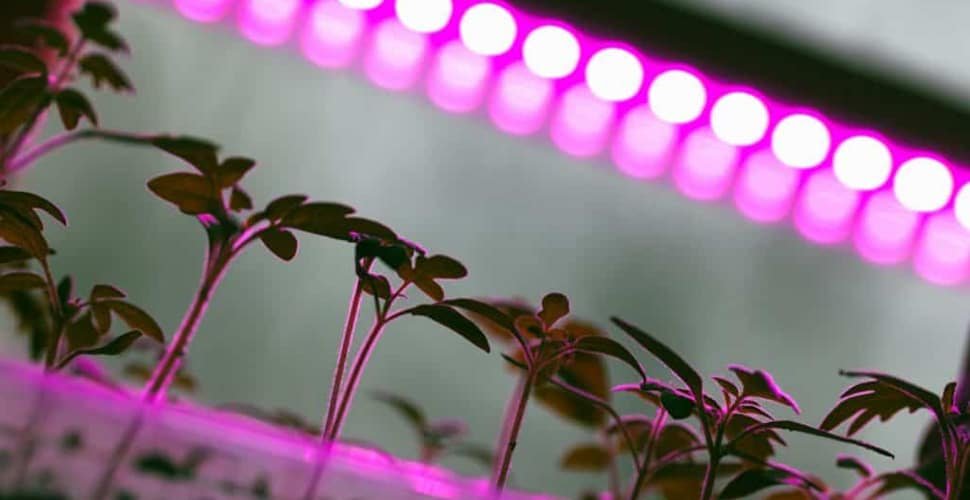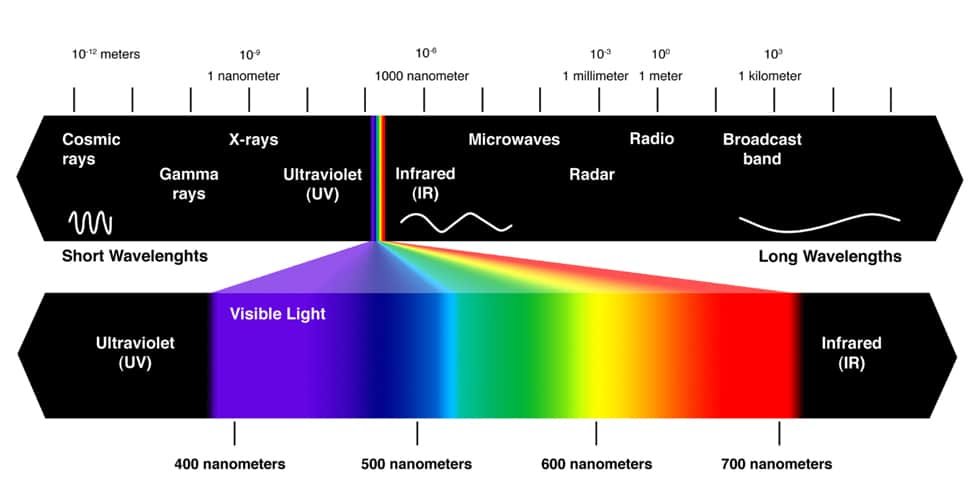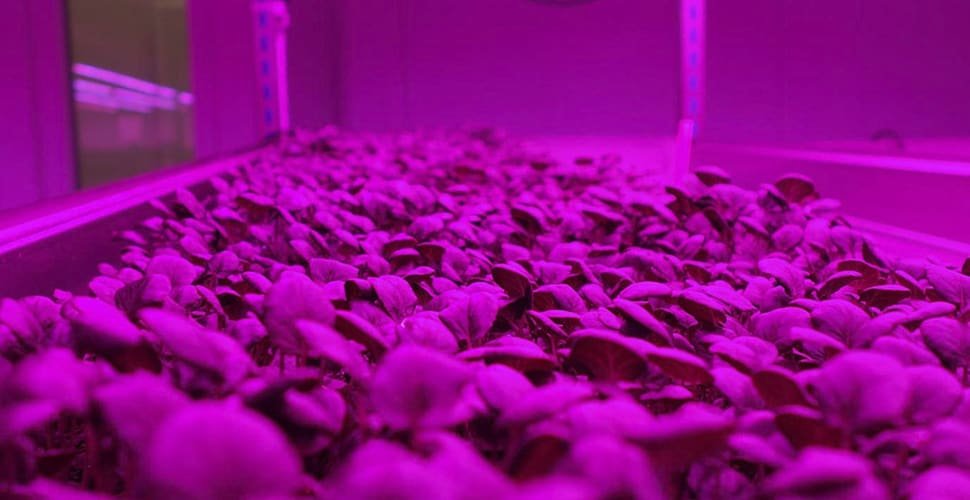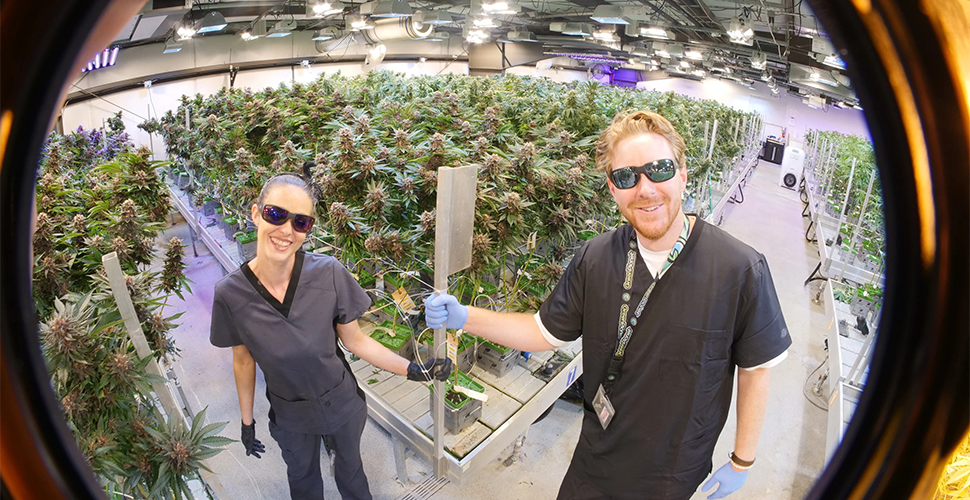جدول المحتويات
اليوم، أضواء النمو الداخلية هي وجود أساسي لزراعة النباتات الداخلية ، وسوف تراها في كل مكان.
هل سبق لك أن لاحظت ظاهرة مثيرة للاهتمام؟ تنمو النباتات بشكل جيد وصحي في الضوء الطبيعي الذي لا يبدو أن له أي لون ، ولكن لماذا تكون الأضواء النمو أرجوانية وبعضها تبدو بيضاء؟
في الواقع ، أضواء LED ليست أرجوانية ، فهي تبدو أرجوانية في أعيننا. نظرًا لأن الأضواء المتنامية الداخلية تنبعث منها الضوء الأزرق والأحمر عالي الكثافة ، وهو مزيج من الأطوال الموجية الأزرق والأحمر في طيف اللون ، وهذا هو المعنى الأرجواني LED. على وجه التحديد ، تعد الأطوال الموجية الزرقاء للضوء مهمة للنمو الخضري في حين أن الأطوال الموجية الحمراء مهمة للإزهار والإثمار.
في هذه المقالة ، سنناقش الأسباب الكامنة وراء مصابيح النمو الأرجواني وما إذا كان الأمر يستحق ذلك. دعنا نغطس!

ما الذي يجعل مصابيح النمو الأرجواني الأرجواني؟
تتكون مصابيح LED من مجموعات مختلفة من الأطوال الموجية التي ستنتج الضوء الذي توفره لنباتاتك. ولكن هناك أكثر من مجرد طول موجي واحد لأي مجموعة ألوان معينة. سوف يحدد مصنعو ضوء نمو النبات أطوال موجية ملونة محددة مفيدة لنمو النبات لإنشاء مصابيح زراعة LED. هدفهم هو إنشاء ضوء مفيد لنباتاتك الداخلية ومحاولة تجنب الضوء الذي لا تحتاجه النباتات.
الطول الموجي واللون

blطول الموجة الضوئية UE بين 430 و 500 نانومتر.
تتراوح أطوال موجات الضوء الأحمر بين 625 و 740 نانومتر.
تتراوح أطوال موجات الأشعة فوق البنفسجية بين 100 و 450 نانومتر.
هناك ثلاثة أنواع من الأطوال الموجية للأشعة فوق البنفسجية ، يستخدم اثنان منها في غرف النمو: UV-A و UV-B.
- UV-C: 100 إلى 290 نانومتر.
- UV-B: 290 إلى 320 نانومتر.
- UV-A: 320 إلى 400 نانومتر.
تتراوح أطوال الموجات الحمراء البعيدة بين 740 و 1050 نانومتر.
اللون الأرجواني المنبعث من مصابيح LED هو مزيج من الأطوال الموجية الزرقاء والأحمر من الضوء التي تشكل معظم المصابيح. أظهرت الأبحاث أن كلا الأطوال الموجية أمران بالغ الأهمية في تطوير النبات ، وهذا هو السبب LED تنمو مصنعي الضوء استخدم أطوال موجية حمراء وزرقاء في أضواءها النمو.
طول موجة الضوء الأزرق
- أطوال موجات الضوء الأزرق تعزز صحة النبات من خلال تنظيم النمو.
يمنع اللون الأزرق لأضواء النمو استطالة الجذعية ، وهو مفيد للنباتات القزمية. تنبع من نباتات أوراق الشجر المعرضة للضوء الأزرق أقصر وأوراق هذه النباتات خضراء داكنة.
لذلك ، سيؤثر الضوء في النطاق الأزرق أيضًا على سمك الأوراق ومحتوى الكلوروفيل الموجود. سوف تكون قادرًا على إنتاج نباتات ذات أوراق خضراء أكبر وأكبر وأكبر اعتمادًا على الاحتياجات الطيفية للنبات.
- الطول الموجي الأزرق يؤثر أيضًا على تلوين الأوراق.
الحرف المنزلي ذو الأوراق الأرجواني مثل غابة بانسي يحتاج إلى إشعاع أزرق. خلاف ذلك ، قد ينتج أوراق خضراء بدون ضوء أزرق. وبالمثل ، فإن الخضر الورقية مثل اللفت والبروكلي سوف تنتج عناصر غذائية صحية مع ضوء أزرق كافي ، مما يحصل على كميات كافية من العناصر الغذائية مثل الفيتامينات أو مضادات الأكسدة.
- الضوء الأزرق يتحكم في ازدهار النباتات.
يمكن للضوء عالي الكثافة من 20 ميكرولول أن تزهر نباتات يوم طويلة مثل السبانخ واللفت والكرفس. كما يمكن أن تمنع الإزهار للنباتات في اليوم القصير مثل chrysanthemums و clivia.
طول موجة الضوء الأحمر
- أطوال موجات الضوء الأحمر تدفع التمثيل الضوئي لتحسين نمو النبات.
بمعنى آخر ، يتمتع الضوء الأحمر بأعلى كفاءة في تحويل الكهرباء إلى فوتونات التمثيل الضوئي. وذلك لأن الضوء الأحمر عادة ما يتم امتصاصه بقوة أكبر بواسطة الأصباغ الخضراء في النباتات.
النباتات المعرضة لمزيد من الضوء الأحمر سوف تنمو أطول. يمكنك استخدام الضوء الأحمر لتعزيز أو منع امتداد الساق. يمكنهم أيضًا إنتاج أوراق أرق ونباتات أكبر وأطول.
نصائح: عليك أن تدرك أنه يجب عليك التحكم في الضوء الأحمر لأن الكثير منه يمكن أن يتسبب في أن تكون النباتات طويلة جدًا ونحيفة.
- وهي مسؤولة عن زيادة معدل التمثيل الضوئي في النباتات.
يؤثر الضوء الأحمر من الأضواء النامية الأرجواني أيضًا على إزهار النبات ، ومن خلال الضوء الأحمر تحصل على أكبر قدر من الطاقة.
مزيج من أطوال موجات الضوء الأزرق والأحمر
بشكل فردي ، يساعد الضوء الأزرق على نمو النباتات ، بينما يساعد الضوء الأحمر على الإزهار والتمثيل الضوئي. الأصفر والأخضر يمتص أقل. تعكس النباتات هذا الضوء وبالتالي فهي خضراء في اللون.
ومع ذلك ، لا يصنع مصنعو ضوء النمو الأعلى مصابيح نباتية تحتوي على جميع الأطوال الموجية أثناء عملية الإنتاج. لأن النباتات لا تمتص كل الضوء على قدم المساواة. وسوف يختارون لون الضوء الصحيح والمحدد وسوف تستفيد أقصى استفادة من مصابيح النمو الداخلية LED. استخدم الأضواء المناسبة ل وفر كمية كبيرة من الكهرباء.
يوفر مزيج من الأطوال الموجية للضوء الأزرق والأحمر النباتات الخاصة بك مع الضوء اللازم لتحفيز جميع أنماط النمو في وقت واحد ، وهو بالضبط ما تحتاجه نباتاتك إلى الازدهار.
مزيجهم مهم لأنه يسمح للنباتات باتباع إيقاعات الساعة البيولوجية حتى في الداخل. السماح للنباتات بمعرفة وقت الانتهاء ومتى تستريح ، تمامًا كما تفعل في الحياة في الهواء الطلق.
بعد اختيار أضواء النمو اليمنى للنباتات الداخلية ، يجب عليك أيضًا الانتباه إلى المسافة التي تضعها عليها ، والمكان الصحيح ل شنقهم وكيفية استخدامها لزيادة الإخراج.
الاعتبارات الاقتصادية

أضواء النمو الأرجواني ليست منطقية لمزارعي المنازل
من وجهة نظر تجارية ، فإن رقائق LED الحمراء والأزرق هي أرخص للشراء. سيستخدم المصنّعون الأوائل لأضواء النباتات النباتية هذا المزيج الخاص من الأطياف لصياغة أي وصفة ضوئية يريدونها. نظرًا لأن LEDs كانت باهظة الثمن في ذلك الوقت ، ركزت بعض الشركات المصنعة فقط على توفير تلك الأضواء الحمراء والزرقاء التي كانت حاسمة للغاية للنباتات.
ولكن في العقد الماضي ، انخفضت تكلفة تقنية LED ، وانخفضت تكلفة التصنيع وتشغيل هذه الأضواء بشكل كبير.
اليوم ، يكلف الضوء الأزرق أو الأحمر من 10 إلى 30 وات للنباتات أقل من 20 دولارًا سنويًا للكهرباء. بالمقارنة مع ضوء نبات كامل الطيف من نفس القوة الكهربائية اليوم ، فإن توفير الكهرباء لضوء النبات الأرجواني ليس سوى دولار أو اثنين في السنة من واحد كامل الطيف.
الاختلاف في توفير الكهرباء ليس كبيرًا بما يكفي لجعل اقتصاديات الأضواء الأرجواني تنمو مصابيح ذات مغزى للمزارعين المنزليين.
اليوم ، يكلف الضوء الأرجواني الأرجواني العادي 10-30W أقل من 20 دولارًا في السنة للكهرباء. بالمقارنة مع طيف كامل ينمو ضوء القوة نفسها اليوم ، فإن وفورات الكهرباء لضوء النبات الأرجواني ليست سوى دولار أو اثنتين في السنة من واحد كامل الطيف. الفرق في تكاليف الكهرباء ليس كبيرًا. لذلك ، لا نعتقد أن اقتصاديات تنمو الأضواء الأرجواني تنمو منطقية لمزارعي المنازل.
ولكن إذا كنت تخطط لاستخدام هذا الضوء الأرجواني للنباتات في جميع أنحاء المستودع وتشغيل عمليات الزراعة الرأسية ، فقد يكون ذلك ذا قيمة أكثر معنى. يستفيد الضوء الأرجواني كثيرًا ، ولكن بالنظر إلى عيوبه الأخرى ، لا نعتقد أن هذا أمر مهم كما كان عليه الحال.

الطيف الأحمر والأزرق ليس فريدًا
بفضل الباحثين في هذا المجال ، بحث وعلم كيفية استجابة النباتات للضوء على مدار العشرين عامًا الماضية ، أثرت معرفتنا بالضوء.
- يؤثر UVA / UVB على الزيوت الأساسية والنكهات والعطور.
- Greenlight جيد جدًا في تغلغل المظلة والورق ، يتفوق على اللون الأحمر والأزرق.
- يعد Red Red مكملاً جيدًا بشكل خاص للأزرق ، ويساعد على تعزيز توسيع الخلايا النباتية.
أضواء النمو الأرجواني ليست ممتعة
هناك معيار لمدى راحة الضوء أو اللطيف للعين البشرية التي نسميها CRI ، أو مؤشر عرض الألوان. ببساطة ، يحدد CRI مدى طبيعية لون كائن ما تحت أنواع مختلفة من الإضاءة.
إذا كان الضوء يبدو غريباً على العين البشرية ، فهو حاد للغاية ويبدو غير طبيعي ، فإن قيمة CRI منخفضة. قد يعني هذا أيضًا أنه ببساطة مزيج من رقائق LED الحمراء والأزرق.
لقد تعلمنا أيضًا أن الأضواء النمو الأرجواني تنبعث منها مجموعة ضيقة من الضوء ، مما يوفر النباتات ذات الأطوال الموجية المحددة للضوء التي تحتاجها للنمو والازدهار. على الرغم من أن الضوء الأحمر أو الأزرق للنباتات مناسب للحدائق الداخلية ، إلا أن درجة حرارة اللون يمكن أن تجعل الناس أقل راحة لفترات طويلة من الوقت. هذا يمكن أن يؤدي إلى إجهاد العين أو الصداع. إذا استخدمت أيضًا ضوء النبات الأرجواني ، فمن المستحسن إحضار نظارتك ، حتى لو كانت ظلال شمس عادية للغاية ، أثناء الاستخدام.
على النقيض من ذلك ، فإن الضوء الذي يبدو ممتعًا بشكل طبيعي للعين البشرية له قيمة عالية CRI وقد يتكون من العديد من مجموعات الألوان المختلفة من رقائق LED.
ملخص
نأمل الآن أن تكون قد وجدت الإجابة على لماذا الأضواء النمو أرجوانية؟ ونأمل أن يجيب هذا المقال على مسألة ما إذا كان من المفيد لك شراء مصباح نبات أرجواني.
اليوم ، لم تعد معظم الأضواء النمو أرجوانية. في رأينا ، هناك خيار أفضل هو ضوء نمو LED طيف كامل يضمن صحة النبات الأمثل وبيئة أكثر راحة.
إذا كنت تعيش في منطقة ساخنة جدًا وتريد أن يشعر داخل منزلك برودة ، فابحث عن الأضواء المصنفة على 5000-5500 ألف. يميل التوزيع الطيفي لهذه الأضواء نحو اللون الأزرق وستكون درجة حرارة الأضواء النمو أكثر برودة نسبيًا.
عندما تعيش في مناخ أكثر برودة أو لديك مساحة أصغر ، نوصي بدرجة حرارة ضوئية أكثر دفئًا في 2700 – نطاق 3500K. هذه هي حمراء منحرفة ولها توهج أكثر دفئا ، يمكن القول أنه أفضل للإثمار والإزهار.
إذا كنت ترغب في معرفة المزيد حول العثور على ضوء النمو المثالي للنباتات الداخلية الخاصة بك ، فإننا نوصي هل مصابيح LED كاملة الطيف جيدة للنباتات؟؟
جايز
بصفته مديرًا للتسويق الرقمي في AUXGROW، يجمع Jayes بين شغف أنظمة الزراعة المائية والخبرة في مصابيح LED للنمو. من خلال الخبرة العملية والفهم العميق، يرشدك جايز عبر عالم الزراعة المستدامة.





